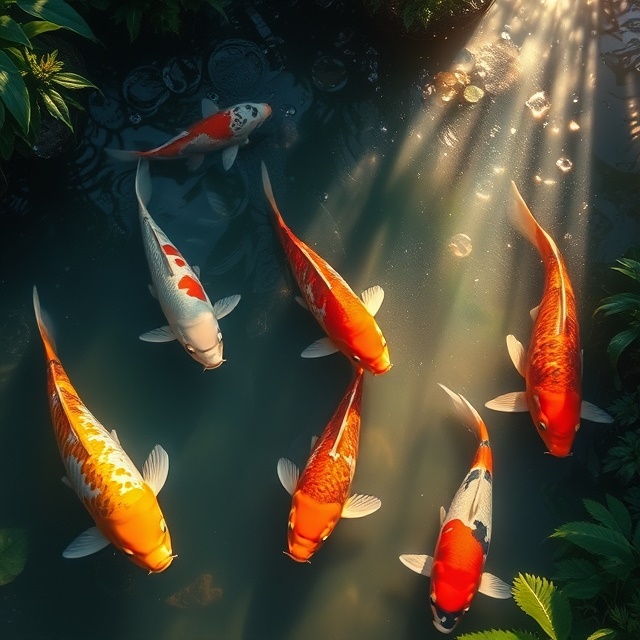Koi fish, also known as Nishikigoi, are ornamental varieties of the common carp (Cyprinus carpio) that have been bred for their vibrant colors and patterns. Their beauty and grace have made them popular in both aquaculture and ornamental ponds worldwide. Understanding koi involves exploring their characteristics, breeding practices, care requirements, and cultural significance.
Characteristics of Koi Fish
Koi fish come in a wide range of colors, sizes, and patterns. Here are some key characteristics that define them:
- Colors and Patterns: Koi are known for their striking colors, which can include red, white, black, yellow, blue, and orange. Different varieties of koi exhibit distinct patterns, such as:
- Kohaku: White with red markings.
- Taisho Sanke: White with red and black markings.
- Showa Sanke: Black with red and white markings.
- Shiro Utsuri: Black with white markings.
- Asagi: Blue with red markings.
- Size: Koi can grow significantly, with some reaching lengths of 2 feet (60 cm) or more. The size they attain is influenced by factors such as genetics, diet, and the environment in which they are kept.
- Lifespan: Koi have a long lifespan, often living 20 to 30 years, and some individuals are known to exceed 200 years in age. Proper care and a suitable environment can significantly impact their longevity.
Breeding Koi Fish
Breeding koi fish is a specialized practice that requires knowledge and attention to detail. Here are the key steps involved in koi breeding:
- Selecting Breeding Stock: The first step is to choose high-quality koi with desirable traits, such as vibrant colors and well-defined patterns. Genetic diversity is also important to produce healthy offspring.
- Spawning Conditions: Koi typically spawn during the warmer months when water temperatures rise. Providing a suitable spawning environment, such as spawning mats or plants, encourages the female koi to lay eggs.
- Egg Care: After spawning, the eggs need to be carefully monitored. They should be kept in clean water with good oxygen levels. The eggs usually hatch within 4 to 7 days, depending on water temperature.
- Raising Fry: Once the koi fry hatch, they require specialized care, including proper feeding with high-quality fry food and maintaining optimal water conditions. As they grow, they will need to be sorted by size to prevent larger fish from bullying smaller ones.
Caring for Koi Fish
Caring for koi fish involves several key practices to ensure their health and well-being:
- Pond Maintenance: Regular maintenance of the koi pond is essential. This includes checking water quality, performing water changes, and ensuring proper filtration and aeration.
- Feeding: Koi should be fed a balanced diet that includes high-quality koi pellets, which are formulated to provide essential nutrients. Supplemental feeding with fruits and vegetables can also be beneficial, but it’s important not to overfeed, as this can lead to water quality issues.
- Health Monitoring: Koi fish can be susceptible to diseases, parasites, and environmental stress. Regular monitoring of their behavior and appearance can help catch health issues early. Signs of illness may include abnormal swimming patterns, loss of color, or visible lesions.
- Seasonal Care: Koi care varies with the seasons. In winter, it’s important to monitor the pond temperature and ensure that the water does not freeze over completely. During warmer months, regular feeding and water quality checks are essential.
Cultural Significance of Koi Fish
Koi fish hold profound cultural significance in various societies, particularly in Japan. Here are some key points regarding their symbolism:
- Symbols of Strength and Perseverance: Koi are often seen as symbols of strength, perseverance, and determination due to their ability to swim upstream against strong currents. They are celebrated in Japanese folklore, where a koi’s journey to become a dragon symbolizes overcoming obstacles.
- Cultural Festivals: Koi fish are featured in many Japanese festivals, such as the Children’s Day celebration, where families fly koi-shaped banners (koinobori) to symbolize their hopes for their children’s success and happiness.
- Art and Aesthetics: Koi are also a popular subject in Japanese art, from paintings to tattoos. Their beauty and grace make them a symbol of beauty and harmony in nature.
- Feng Shui: In Chinese culture, koi fish are considered symbols of good luck and prosperity. They are often incorporated into feng shui practices to attract positive energy and abundance.
Conclusion
Koi fish are not only captivating creatures but also symbols of cultural significance, beauty, and resilience. Their rich history, vibrant colors, and graceful movements make them cherished companions in ornamental ponds and gardens. By understanding koi fish and their care requirements, enthusiasts can enjoy the rewarding experience of raising these remarkable fish, while also connecting with the cultural traditions and meanings that surround them. Whether you are a seasoned koi keeper or just beginning your journey, the world of koi offers endless beauty and inspiration.

